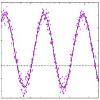Citation:

Abstract:
Phase modulated sub-picosecond pulses are converted by a time-to-space processor to quasi-monochromatic spatial beams that are spatially demultiplexed and coherently detected in real-time. The time-to-space processor, based on sum-frequency generation (SFG), serves as a serial-to-parallel converter, reducing the temporal bandwidth of the ultrashort pulse to match the bandwidth of optoelectronic receivers. As the SFG process is phase preserving, we demonstrate homodyne coherent detection of phase modulated temporal pulses by mixing the demultiplexed SFG beam with a narrow linewidth local oscillator (LO) resulting in single-shot phase detection of the converted pulses at a balanced detector. Positively and negatively phase-modulated signal pulses are individually detected and LO shot noise limited operation is achieved. This demonstration of real-time demultiplexing followed by single-shot full-field detection of individual pulses, highlights the potential of time-to-space conversion for ultrahigh bit rate optical communications and data processing applications.

